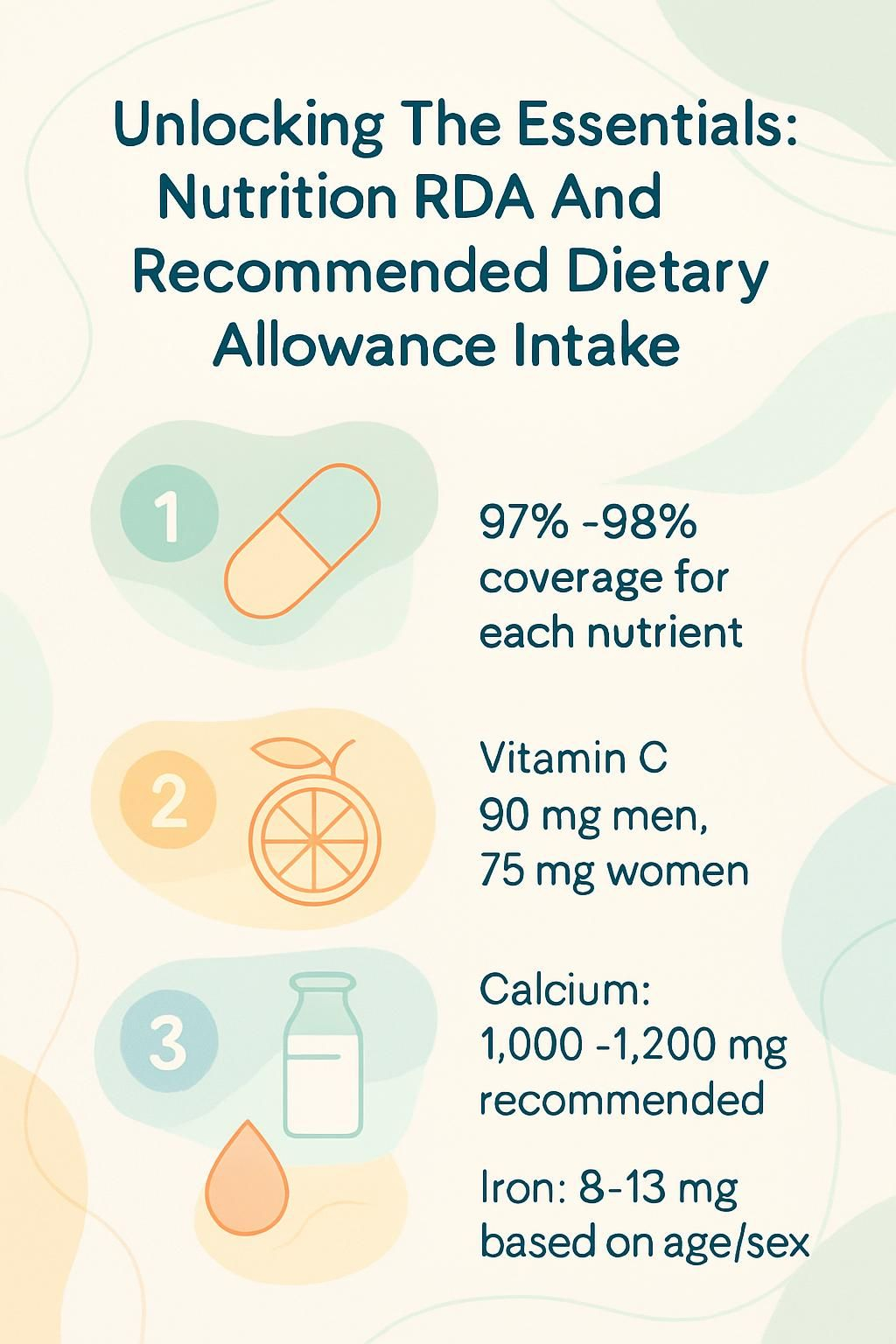Unlocking The Essentials: Nutrition RDA And Recommended Dietary Allowance Intake
Our Nutrition Assistant AI Suite will transform your body. You will lose fat, get toned, and build muscle. Gain confidence and optimal health.
It is easy to feel unsure about how much of each nutrient you need. The Recommended Dietary Allowance, often shortened to RDA, gives daily targets you can use with any nutrition facts label or supplement facts label. These targets come from Dietary Reference Intake, or DRI, reports and help you plan a healthy intake.
This article explains how the Food and Nutrition Board sets these nutrition recommendations, how to use DRIs in daily meal planning, and how Daily Value, or DV, on labels differs from RDA. You will learn simple ways to check your nutrient intake and make confident food choices.
Key Takeaways
- The Recommended Dietary Allowance (RDA), set by the Food and Nutrition Board since 1941, is designed to cover 97% to 98% of healthy people in each age and sex group.
- Dietary Reference Intakes (DRIs) include RDA, Estimated Average Requirement (EAR), Adequate Intake (AI), Tolerable Upper Intake Level (UL), and Acceptable Macronutrient Distribution Ranges (AMDR). Expert panels update these using research from sources such as the National Academies.
- Examples of adult RDAs: vitamin C, 90 mg for men and 75 mg for women; calcium, 1,000 to 1,200 mg; iron, 8 to 18 mg depending on age and sex.
- Nutrition Facts use % Daily Value (%DV) based on DRIs so you can compare foods and aim for safe ranges regulated by the FDA.
- RDA targets change across life stages, such as pregnancy and older age. Seek personal advice if you have a medical condition or special nutrition needs.

What is Recommended Dietary Allowance?

Recommended Dietary Allowance sets clear daily targets for essential nutrients. Health educators and clinicians use these values to guide food choices and support nutrition labeling and counseling.
What does Recommended Dietary Allowance (RDA) mean?
RDA values are daily reference numbers that show how much of each essential nutrient most healthy people need. The Food and Nutrition Board of the Institute of Medicine first set these values decades ago using scientific evidence.
RDAs aim to meet the needs of 97% to 98% of healthy people in a specific age and sex group. Needs change by group, such as higher vitamin C for adult men than for adult women, and higher needs during pregnancy.
On a nutrition facts label, you will see % Daily Value that reflects these reference values so you can compare your intake with dietary recommendations. During high school sports, I used these numbers to plan meals. My energy and recovery improved once I met my daily targets.
Health professionals rely on RDAs to create safe, realistic plans that help you meet your nutritional requirements.
The RDA is not a magic number, but it helps guide healthy food choices every day.
Why is RDA important in nutrition?
Once you understand what RDA means, it is easier to see why it matters. RDAs act as dependable targets that help protect most healthy people in each age and sex group from deficiency.
These values come from research reviewed by independent expert panels, including the National Academies of Sciences, Engineering, and Medicine. By setting minimums for vitamins and minerals, RDAs help prevent problems like scurvy or rickets.
RDAs also shape the Dietary Guidelines for Americans and rules for nutrition labeling. You benefit whenever you read Nutrition Facts or Supplement Facts on packaged foods or dietary supplements.
Clinicians use RDAs to advise people on safe intake of nutrients such as calcium, iron, sodium, and vitamin K. If you are pregnant or nursing, specialists like Teresa Fung, MS, RD, ScD suggest following life stage RDAs to support your health and your baby’s development.
These values support growth, energy balance, and lower the risk of long-term disease. In short, RDAs guide policy and daily choices that protect your nutrition status.
Understanding Dietary Reference Intakes
Dietary Reference Intakes, used in the United States and Canada, provide scientific nutrient targets you can apply to everyday decisions. Think of them as a map for healthy intake.
What are the components of Dietary Reference Intakes: RDA, EAR, AI, and UL?
DRIs bring together several kinds of reference values. Each one serves a different purpose in planning and evaluating diets.
- The RDA gives an average daily intake that meets the needs of 97% to 98% of healthy people in a group by age and sex. Use RDA values to plan meals or interpret labels.
- EAR, or Estimated Average Requirement, meets the needs of 50% of healthy people in a group. When possible, experts set the RDA from the EAR.
- AI, or Adequate Intake, is used when evidence is not strong enough to set an RDA. AIs come from observed intakes that appear to be sufficient in healthy groups.
- UL, or Tolerable Upper Intake Level, shows the highest daily intake that is unlikely to cause harm for almost everyone in a group.
- DRIs also include AMDR, which gives safe ranges for carbohydrates, proteins, and fats that support energy and lower chronic disease risk.
- DRI reports cover nutrients such as vitamin D, calcium, folate, potassium, and sodium, using research reviewed by the National Academy of Sciences.
- The Food and Drug Administration uses DRI values when creating Nutrition Facts and Supplement Facts labels for foods and dietary supplements.
- Scientists base each DRI on studies of nutrient needs across ages, weights, and life stages, plus lab measures like blood markers. They consider variation in the population when they set these values.
- ULs protect you against toxicity from excessive supplement use or heavy fortification while keeping long-term intakes safe across the population.
How does RDA differ from other Dietary Reference Intake components?
RDA, EAR, AI, and UL work together, but they answer different questions. The RDA sets an intake that covers almost everyone in a specific group, so it is a daily target for most people.
EAR meets only half of the group’s needs, which is why it does not work as a goal for individuals. AI steps in when there is not enough research to set a precise RDA, as with choline or dietary fiber in some age groups.
The UL addresses safety. It marks the highest daily amount you can consume without a likely risk of toxicity, which matters for nutrients like vitamin A or selenium.
AMDR is different from these. It gives safe ranges for macronutrients such as fats and carbohydrates to support health rather than prevent deficiencies.
How Are RDAs Determined?
Experts use a blend of research, statistics, and clinical judgment to set RDAs. These steps help turn data into practical guidance for your plate.
What role does Estimated Average Requirement (EAR) play in setting RDAs?
EAR is the starting point. Researchers at the National Academies review studies and set the EAR for each nutrient, which meets the needs of 50% of healthy people in a group.
Then they raise that value to set the RDA so it covers 97% to 98% of people in the same group. If there is not enough evidence to set an EAR, the committee sets an AI instead of an RDA.
When I helped my grandmother after she turned 70, I used the RDAs to plan meals with enough protein, whole grains, fish, vegetables like soy products, and nuts like peanuts. Her strength and energy improved.
This approach keeps intakes within safe ranges and below the UL.
Which factors influence RDA calculations?
EAR provides a baseline, but several other factors shape the final RDA values. These adjustments help the values fit real people and real diets.
- Age changes needs as growth, body weight, and tissue development shift across life. Children, adults, and older adults have different targets.
- Gender matters. For example, women of childbearing age often need more iron than men due to blood loss during menstruation.
- Pregnancy and lactation increase demands for protein, calcium, and other nutrients to support growth and milk production.
- Bioavailability, or how well the body absorbs a nutrient, varies by source. Animal foods, dairy, eggs, and plant foods like chickpeas can differ in absorption.
- Activity level affects energy and protein needs. People who train often may need higher intakes to support muscle and tissue repair.
- Health status can change absorption or losses, so people with certain conditions may need different guidance.
- Dietary patterns influence typical intakes. High added sugar or very low meat or cheese diets may need special focus to meet targets.
- New studies prompt periodic updates. Committees weigh fresh evidence on requirements, safety, and planning.
- Nutrient interactions matter. For instance, high calcium can reduce iron and zinc absorption.
- Safety margins and population variation are built in so the RDA protects nearly all healthy people.
- Subgroups like infants and older adults have tailored values for nutrients such as vitamin D or fluoride.
What scientific research supports RDAs?
Committees draw on clinical trials, population studies, and metabolism research. For instance, vitamin C intake that prevents scurvy helped shape its DRI.
Calcium needs for strong bones come from studies across ages and life stages. The National Academy of Sciences oversees these panels, which rely on systematic reviews and balance studies in human biology.
Experts look at different groups and identify intakes that prevent deficiency and excess for nutrients such as biotin, pantothenic acid, heme iron in beef, selenium, and chromium. Public review helps keep the process transparent.
These findings shape Reference Daily Intake values on food labels so you can meet the RDA using accurate nutrient content data for foods and supplements.
Nutrients Covered by RDAs
RDAs cover nutrients that keep your body working well, from energy to tissue repair. Knowing these targets helps you plan meals and use supplements wisely if needed.
What are the RDAs for macronutrients: carbohydrates, proteins, and fats?
Meeting macronutrient targets supports energy, strength, and focus. Use these values as starting points, then adjust portions to match your needs.
| Macronutrient | RDA/AMDR | Reference Daily Value (DV) | Purpose & Examples |
|---|---|---|---|
| Carbohydrates | RDA: 130 g/day (adults and children 1 year and older) AMDR: 45-65% of total daily calories | 275 g (based on 2,000-calorie diet) | Supports brain function and energy needs. Whole grains, fruits, vegetables, legumes. |
| Protein | RDA: 0.8 g/kg body weight/day (adults) AMDR: 10-35% of total daily calories | 50 g (based on 2,000-calorie diet) | Builds and repairs tissues. Meat, dairy, beans, tofu. |
| Fat | AMDR: 20-35% of total daily calories (adults) No specific RDA, but essential fatty acids are required:
| 78 g (based on 2,000-calorie diet) | Provides essential fatty acids, supports heart and brain health. Oils, nuts, fish, seeds. |
- AMDR ranges for adults are 45-65% carbs, 10-35% protein, and 20-35% fat.
- Alpha-linolenic acid, an omega-3 fat, supports heart and brain function.
- Protein RDA changes with age and sex, but the label DV is set at 50 g.
- Reference DVs translate DRIs for easy use on labels.
What are the RDAs for micronutrients: vitamins and minerals?
Micronutrients help your body run smoothly. The table below lists key RDAs and DVs that appear on labels and in DRI tables.
| Micronutrient | Reference DV / RDA | Life Stage/Notes | Key Facts |
|---|---|---|---|
| Vitamin D | 20 mcg (800 IU) | Adults | Required on labels |
| Calcium | 1300 mg | Adults, teens | Reference DV; Required on labels |
| Iron | 18 mg | Adults (female 19-50) | Required on labels; Higher needs for menstruating women |
| Potassium | 4700 mg | Adults | Reference DV; Required on labels |
| Folate (Folic Acid) | 400 mcg DFE | Adults | Reference DV; Crucial for pregnancy |
| Vitamin A | 900 mcg (men), 700 mcg (women) | Adults | Supports vision and immunity |
| Vitamin C | 90 mg (men), 75 mg (women) | Adults | Supports immune health |
| Vitamin B12 | 2.4 mcg | Adults | Prevents anemia |
| Biotin | 30 mcg | Adults | Reference DV; Supports metabolism |
| Sodium | 2300 mg | Adults | Reference DV; Excess linked to hypertension |
| Magnesium | 420 mg (men), 320 mg (women) | Adults | Supports muscles and nerves |
| Zinc | 11 mg (men), 8 mg (women) | Adults | Required for immunity |
In daily life, use labels to confirm you are on track. Maybe your cereal covers 25% of the folic acid DV at breakfast. I plan for leafy greens and lean meats to reach iron and vitamin A targets because I notice low energy if I miss them.
Labels must include vitamin D, calcium, iron, and potassium so you can monitor these closely. Many nutrients also have ULs that prevent toxicity, which is important if you take dietary supplements.
To personalize your plan, consult DRI tables by age and life stage. Some labels list extra vitamins or minerals if a product is fortified. Tools like USDA FoodData Central help you check the foods you eat most often.
How are water and electrolytes considered in RDAs?
DRI reports include water and electrolytes such as sodium, potassium, and chloride. These nutrients support digestion, hydration, and healthy body weight.
The DV for sodium is 2,300 milligrams. The DV for dietary fiber is 28 grams. DRI tables list water needs by age and sex since hydration changes across life.
Committees evaluate electrolytes for both adequacy and safety. Many of these values are AIs rather than RDAs. During long runs, I track sodium and potassium so I can prevent cramps and fatigue. That habit keeps my intake in a safe range on hard training days.
Electrolytes and water are essential parts of your plan. Macronutrients also have targets that support energy and performance.
Importance of RDAs for Different Life Stages
RDA values change with age and life stage. Matching your plan to your group keeps your nutrition on target.
What are RDA considerations for infants and children?
Infants and children grow quickly, so their nutrition needs are unique. Following RDA or AI values helps protect development and long-term health.
- Pediatric RDAs guide daily intake for vitamins, minerals, carbohydrates, proteins, and fats; the Food and Nutrition Board sets these values in the U.S.
- DRI tables give specific targets by age, including 0-6 months, 7-12 months, 1-3 years, and beyond.
- Infants often need more nutrients per pound than adults due to rapid growth and tissue formation.
- AI replaces RDA when the evidence is limited, such as for some infant nutrients like vitamin D or potassium.
- Water and electrolytes help maintain hydration and cell balance; breast milk commonly covers most needs and formulas are regulated to align with guidelines.
- Energy needs are high during infancy, often 80 to 120 kcal per kilogram of body weight each day.
- Micronutrient tables help caregivers check targets for iron, calcium, zinc, vitamin A, and others.
- Age and sex affect needs in older children. For example, boys after age 9 may need more protein as muscle mass grows.
- RDAs support planning for hospitals, schools, and daycare menus, as well as design of supplements for children.
- Early childhood targets aim to support brain growth, a strong immune system, and steady weight gain.
Next, see how RDAs support healthy pregnancy and nursing.
Why are RDAs important for pregnant and lactating women?
Pregnancy raises vitamin and mineral needs for both parent and baby. The Food and Nutrition Board sets higher RDAs for key nutrients such as folate, iron, and calcium during pregnancy.
For example, 600 micrograms of folic acid daily in pregnancy can help prevent neural tube defects. Calcium needs are about 1,000 milligrams per day to support bone health for parent and child.
Needs stay higher during lactation. For instance, vitamin A rises from 700 micrograms RAE to 1,300 micrograms RAE per day for many nursing adults age 19 and older. Meeting these targets helps prevent deficiencies that could affect both of you.
Understanding how RDAs shift by life stage also matters for infants and children, as well as older adults.
How do RDAs apply to adults and the elderly?
DRI tables give different RDAs for adults age 19 and older and for seniors starting around age 51. As one example, the calcium target increases from 1,000 mg to 1,200 mg per day for many women over age 50 to reduce fracture risk.
Absorption changes with age, which affects vitamin D needs. A dietitian suggested extra vitamin D for my grandparents, and checking labels made the change simple.
Following RDAs helps maintain bone strength and muscle as metabolism slows. Nutrition Facts also show DVs that may not reflect older adult needs exactly, so use the DRI tables for precise targets.
Variations in RDAs
Your needs shift over time. Age, sex, and lifestyle can change how much of a nutrient you need each day.
How do age and gender affect RDA recommendations?
Age and gender are major drivers of your RDA targets. Always check your group in the DRI tables before planning.
- Women ages 19 to 50 generally need 18 mg of iron per day due to menstruation. Men in the same age range need about 8 mg.
- Many women after menopause require 1,200 mg of calcium daily, while many men need 1,000 mg until age 70.
- Growth and hormones change needs during childhood and puberty. Teens often require more of certain nutrients.
- Older adults may absorb less vitamin B12 and vitamin D, which raises their recommended intake.
- Activity matters, but age remains a key factor in setting your baseline targets.
- When I moved from late teens into adulthood, I checked the tables and adjusted my intake. Energy and focus improved once my plan fit my life stage.
- Labels display %DV based on general adult values. Your exact RDA comes from the DRI charts for your age and sex.
How do activity level and lifestyle influence RDAs?
Your daily routine affects your intake needs. Exercise, work demands, and hydration all change the picture.
- Higher activity raises needs for some macronutrients, especially protein and electrolytes. Athletes and frequent exercisers often benefit from a higher protein intake.
- People with physically demanding jobs may require more energy and nutrients than those with sedentary routines.
- DRIs are built for healthy people. Professional athletes or those with intense training often need tailored guidance.
- Sweating increases sodium and potassium losses. Water and electrolytes should match your level of activity.
- Total energy use rises with activity. Carbohydrate and fat needs shift to maintain balance and performance.
- Use %DV on labels as a quick guide, then match choices to your activity level to avoid gaps or excess.
- Work with a healthcare professional if your lifestyle changes a lot or if you start a new training plan. The baseline RDA might not meet your needs.
- Professional help can also adjust for changes in bioavailability due to your diet pattern or supplement routine.
- Stress, travel, and irregular schedules can affect your intake needs for certain vitamins and minerals.
When should RDAs be adjusted for health conditions?
Some health conditions require customized intake. Diabetes, kidney disease, cancer, and other conditions may change needs for specific vitamins and minerals.
Medicines can also change absorption or losses. For example, some drugs lower vitamin D or potassium in the body. Since RDAs guide healthy populations, they may not fit medical needs.
Healthcare professionals and dietitians use the DRI system to tailor advice. If you have a special diet or condition, a clinician can create a plan that fits you. RDAs are guidelines, not prescriptions for illness, so seek expert help before making big changes.
How Can You Use RDAs in Daily Life?
RDA and Dietary Reference Intake values turn labels into useful tools. With a few habits, you can track your nutrients with less effort.
How do you read nutrition labels and % Daily Value?
Labels show what is in your food and how it fits your day. Learning %DV makes planning easier.
- Start with serving size. All numbers on the label refer to this amount.
- Check calories per serving. %DV is based on a 2,000 calorie daily intake.
- Review total fat, saturated fat, trans fat, cholesterol, sodium, total carbohydrate, fiber, total sugars, added sugars, and protein. Compare foods and choose options that support your RDAs.
- Find vitamin D, calcium, iron, and potassium. The FDA requires amounts and %DV for these. For example, one cup of milk might provide 20% DV for calcium.
- Read %DV for a quick guide. Five percent or less means low, 20% or more means high.
- Use these values to spot foods that help meet your targets based on your RDA group.
- Notice units such as grams, milligrams, or micrograms for vitamins and minerals. Aim for the amounts that match your age and life stage.
- Compare similar foods by %DV to find the best fit. A cereal with higher iron %DV may help if you are at risk of low iron.
- Scan the ingredient list under the panel for allergens or additives that matter to you.
- Reading labels helped me cut back on sodium. Some canned foods had 30% DV per serving, which added up fast.
How can meal planning align with RDA guidelines?
Once you understand labels, use that knowledge to build meals that match RDA targets. A simple plan keeps you consistent.
- Include fiber, vitamin D, calcium, iron, and potassium rich foods each day.
- Balance macronutrients within AMDRs. A common daily plan is about 50 g protein, 78 g fat, and 28 g fiber with carbs making up the rest, then adjust to fit your needs.
- Use MyPlate and Nutrition Facts together. Set portions so each food group helps you meet your RDA for age and sex.
- Limit saturated fat, sodium, and added sugars. These crowd out nutrient dense foods and raise health risks.
- Check DRI charts or USDA FoodData Central to confirm intakes for micronutrients such as 1,300 mg calcium or 18 mg iron when needed.
- Increase key nutrients during pregnancy or lactation. Folate, listed as 400 mcg DFE in many charts, often rises in pregnancy based on DRI guidance.
- Track intake with a diary or app. Compare your average intake to target values and DVs.
- Consult a registered dietitian if you have medical needs or a very active lifestyle that changes requirements.
- Eat a wide variety of foods. Variety makes it easier to meet both AMDRs and micronutrient RDAs.
During college, using MyPlate and labels helped me plan balanced meals within a tight budget. I could still hit key RDAs and stay energized for classes and work.
When should you consult healthcare professionals about RDAs?
Seek professional advice if you are pregnant, breastfeeding, older, taking medication, or managing a health condition. These factors can change how RDAs apply.
Doctors and registered dietitians can review your health status, medication list, and diet. If you follow a restrictive plan, such as vegan or gluten free, an expert can help you meet targets safely.
Guidance is also useful for supplements. A provider can check for interactions and the risk of exceeding safe levels.
A dietitian helped me adjust vitamin D during winter. Expert input kept my plan safe and on target. This article is for education only and does not replace medical advice.
What Are the Challenges in Meeting RDAs?
Many people fall short of certain nutrients or go too high on others. With the right steps, you can close common gaps.
What are common nutrient deficiencies and their effects?
Deficiencies happen when intake stays below targets for weeks or months. Some lead to serious symptoms, which shows why meeting RDAs matters.
- Vitamin C deficiency can cause scurvy with swollen gums, fatigue, and slow healing. Setting RDAs reduced this risk in modern diets.
- Low vitamin D can cause rickets in children and soft bones in adults. Eating vitamin D rich foods and getting safe sun exposure can help.
- Iron deficiency, a common problem, may cause anemia, fatigue, and poor focus. Needs rise in children, pregnant adults, and older adults.
- Inadequate calcium raises the risk of bone loss later in life, especially in many women after menopause.
- Low B12 or folate levels can lead to nerve issues or birth defects if pregnant adults fall short.
- Too little iodine may cause thyroid problems. Iodized salt helped lower this risk in the United States.
- Missing potassium can raise blood pressure or cause irregular heartbeat because potassium supports electrolyte balance.
- Zinc deficiency can slow growth in children and weaken immunity. Wound healing can also slow with low zinc.
- Low magnesium sometimes causes muscle cramps or mood changes since it helps regulate nerves and muscles.
Nutrition labels highlight key nutrients so you can track intake with %DV. These tools grew from rules such as the Nutrition Labeling and Education Act.
What are the risks of overconsumption and nutrient toxicity?
Excess intake can be harmful. The UL shows the safe upper limit for each nutrient to reduce toxicity risk.
Taking more than the UL, often from supplements or heavy fortification, raises the chance of side effects. Too much vitamin A can harm the liver. Iron overload can damage organs.
Fat soluble vitamins A, D, E, and K carry higher risk because your body stores them. Chronic overuse can cause symptoms such as nausea or headaches, and long term damage in severe cases.
Use labels and DRI tables to keep intake within safe ranges. This protects your health while you reach your goals.
What are common misconceptions about nutrient needs?
The biggest myth is that more is always better. RDAs are set to cover nearly all healthy people, which means going far above does not add benefit and may add risk.
Daily Values on labels reflect a 2,000 calorie plan and may not match your life stage or activity level. A teen athlete and a retired adult have different needs.
Many people think everyone needs supplements. In many cases, a balanced diet can meet needs. Some nutrients use AI or UL instead of RDA when research is limited.
Labels cannot be fully personalized. Use DRIs and, when needed, professional guidance to tailor your intake.
Tools and Resources for Understanding RDAs
Online tools make it easier to check your targets and plan meals. A few minutes with the right resource can clarify your day.
What online DRI tools and calculators are available?
Trusted tools can match targets to your age, sex, and life stage. Many professionals use these same platforms when counseling patients.
- The DRI Calculator for Healthcare Professionals from the National Academies estimates daily nutrient needs using your age, sex, weight, height, and activity level.
- USDA FoodData Central has detailed nutrition data for thousands of foods, including macros and micronutrients.
- CDC Nutrition Data Tables provide current RDA charts and DRI summaries that reflect new research.
- MyPlate Plan creates meal outlines based on calorie needs, using RDA guidelines for targets.
- NIH Office of Dietary Supplements offers interactive factsheets and tools to compare usual intake with recommended values.
- The Academy of Nutrition and Dietetics lists practical calculators, such as for protein needs or body mass index.
- Health Canada’s DRI tables give quick lookups similar to U.S. RDAs and reflect Canadian data.
- Dietitians rely on these tools to build individualized, evidence based plans.
- Most platforms are user friendly for home meal prep and planning.
These resources help you see if your intake meets the Recommended Dietary Allowance for each nutrient.
Where can you find RDA tables and charts?
If you want the original charts, several reliable sources post them for free. These references make it easy to check any nutrient.
- The Food and Nutrition Board publishes DRI tables and reports with RDA, AI, UL, and EAR values.
- The National Academies website has downloadable charts for vitamins, minerals, and macronutrients.
- USDA FoodData Central includes reference tables and food composition data.
- The FDA posts Reference Daily Values and DRI charts for different age groups.
- Government sites such as the CDC share updated DRI table summaries.
- Full DRI reports, from 1997 to today, are available through the National Academies Press.
- Registered dietitians often provide printed handouts with RDA and AI information.
- Textbooks and study guides include summary charts sourced from USDA and FDA data.
- University extension programs host downloadable PDFs based on the latest updates.
How to use USDA FoodData Central and other databases?
Standard RDA charts are helpful, but tracking your intake requires a practical tool. USDA FoodData Central makes it simple to compare foods to your targets.
- Go to USDA FoodData Central to view thousands of foods and their nutrient profiles.
- Search any item, including American Indian or Alaska Native foods, for accurate data.
- Find details on compounds like proanthocyanidins, flavonoids, choline, iodine, fluoride, isoflavones, and glucosinolates using advanced filters.
- Use these values to compare your daily totals with RDAs and spot gaps.
- Download updated tables, which reflect new research and composition releases.
- Track meals with FoodData Central tools, which support personal and professional analysis.
- Compare foods side by side before you shop or plan meals.
- Check RDA targets shown in the data to prevent overuse or deficiencies based on age and sex.
- Download data to review offline if you are planning away from the internet.
- I use this database to see if a snack meets my protein goal or if I need a higher iron option.
Benefits of Following RDAs
RDA targets give you a simple path to better nutrition. With clear numbers, it is easier to build meals that work for your life.
How do RDAs help maintain overall health and well-being?
RDAs provide daily intake levels that cover almost all healthy people in each group. These targets are based on research and the EAR.
Meeting RDAs lowers the chance of common gaps, such as low iron or vitamin D, which affect energy and immunity. Use RDA values when checking labels or planning meals.
RDA targets also change across life stages. During college, following protein and iron targets helped me keep steady energy. A few smart swaps made a big difference.
Clear guidance reduces guesswork and helps you meet changing needs with confidence.
How can RDAs reduce the risk of chronic diseases?
Consistently meeting RDAs protects your body from deficiencies linked to chronic problems. These include bone weakness, anemia, and some heart risks.
Because RDAs match the needs of 97% to 98% of healthy people, they are reliable targets for prevention. Planning with these values can also reduce medical costs tied to poor intake.
Using tools like USDA FoodData Central helps you track daily nutrition and fix gaps early. My lab results improved after I began planning with RDA targets.
In short, the DRI framework supports a balanced diet that reduces long-term risk.
How do RDAs support energy balance and body functions?
RDAs set daily intakes that help your body make energy, repair tissue, and support vital functions. Hitting these numbers helps prevent tiredness and illness.
If you meet your protein and carbohydrate targets, your muscles and brain have the fuel they need. Labels and %DV help you check if foods match your RDA goals.
Clinicians use RDAs to assess diets for children, adults, pregnant people, and older adults. Current DRI tables show the exact values needed to stay in balance at each stage of life.
RDAs and Dietary Supplements
RDAs help you decide if a supplement is needed and how to choose one wisely. A careful approach keeps intake safe.
When are dietary supplements necessary?
Supplements may be needed when food alone cannot cover your needs. A doctor might suggest iron for diagnosed anemia or vitamin D for low sun exposure.
Pregnancy, certain illnesses, and digestive issues can raise needs. Personalized assessment, including lab tests, helps confirm if a supplement is right for you.
Ask a qualified professional before starting any supplement so you avoid excess and match your actual needs.
How to choose supplements based on RDAs?
Once you know a supplement could help, use RDAs to pick the right dose. The goal is to meet your target without going over safe limits.
- Check the label for %DV. This number is based on RDA values for a 2,000 calorie plan.
- Select products close to 100% of your RDA for your age, sex, and life stage. Avoid very high amounts unless advised by a clinician.
- Use a trusted calculator from a credible source to estimate your personalized needs.
- Choose single nutrient products only when a specific deficiency or increased need is confirmed.
- Count both food and supplements so your total stays below the UL.
- Pick brands that use third party testing such as USP, NSF International, or ConsumerLab.
- Compare your plan with RDA tables from USDA or the Institute of Medicine.
- Talk to your clinician before starting any new product, especially if you take medication.
How to avoid risks of over-supplementation?
Check both the RDA and the UL before taking supplements. Use DVs on labels to keep intake below safe limits.
Look up your age and life stage in the official DRI tables. If unsure, speak with a registered dietitian or healthcare professional.
I once boosted vitamin D on my own in winter and developed headaches. My doctor adjusted the dose using my lab results and the adult RDA. Small changes can prevent bigger problems.
This guidance supports safe intake while you work toward your health goals.
Future of RDAs and Nutritional Guidelines
Nutrition science continues to grow. Updates improve how RDAs guide your daily choices.
What advances are happening in nutrition science and personalized RDAs?
New tools and data are helping experts personalize intake targets. Your age, sex, activity, and health status shape what is right for you.
The Food and Nutrition Board updates DRIs as research grows, giving clinicians better tools for precise assessments. Someone highly active or managing a condition may need different targets than others.
Registered dietitians can tailor advice that prevents deficiencies and reduces disease risk. After working with a dietitian who considered my schedule and training, I met my goals more easily.
How do global disparities affect RDA recommendations?
Countries differ in foods, diets, and nutrient availability. RDAs from one region may not fit another region without adjustment.
For example, iron from plant heavy diets is less absorbable than iron from animal sources. Populations that rely on plant foods may need higher intake targets.
Limited local data can lead to AI values instead of precise RDAs. As new studies appear, committees update guidance to reflect diverse lifestyles and environments.
What are emerging trends in nutrient intake guidelines?
Current trends focus on preventing chronic diseases and personalizing guidance, not just avoiding deficiency. DRI values include RDA, AI, UL, and AMDR to support a broader view of health.
Labels use DVs to make comparisons easier, though they are not personalized. The FDA updated DV standards to improve clarity, which helps you make better choices.
Reviewing updated labels helped me plan meals that fit my energy needs and life stage. Small tweaks made the process easier.
Conclusion
Understanding your Recommended Dietary Allowance gives you a strong base for better health. DRIs offer practical reference values so you can choose foods that meet your needs at every stage of life.
These science based targets reduce the risk of both gaps and excess. Reading labels, using %DV, and checking trusted tools make planning simpler and safer.
You can take charge of your nutrition with steady habits and reliable data. For personal guidance, consult a healthcare professional or registered dietitian, especially if you have a medical condition or take medication.
This educational content supports informed choices. Use it to plan meals, compare options, and build a daily intake that works for you.
FAQs
1. What does RDA mean in nutrition, and why is it important?
RDA stands for Recommended Dietary Allowance. It refers to the daily intake level of a nutrient considered sufficient for most healthy people. The RDA helps guide food choices and supports overall health by preventing deficiencies.
2. How are RDAs determined, and who sets them?
Nutrition experts review scientific studies to set RDAs. Committees such as the Food and Nutrition Board in the United States analyze data from clinical trials, population surveys, and laboratory research before recommending specific amounts for each nutrient.
3. Can you give an example of how following RDA guidelines benefits health?
Meeting the calcium RDA can help maintain strong bones throughout life; I once improved my bone density after increasing dairy foods based on these recommendations. Following RDAs also reduces risk for conditions like anemia or scurvy by ensuring enough iron or vitamin C is consumed.
4. Where can I find accurate information about current nutrition RDAs?
Reliable sources include government websites like the National Institutes of Health Office of Dietary Supplements or published tables from recognized organizations such as the Institute of Medicine; these resources provide up-to-date values based on recent evidence.
Summary: Understanding nutrition RDA helps individuals make informed dietary decisions that support long-term well-being; using credible sources ensures accuracy when applying this knowledge in daily life.







